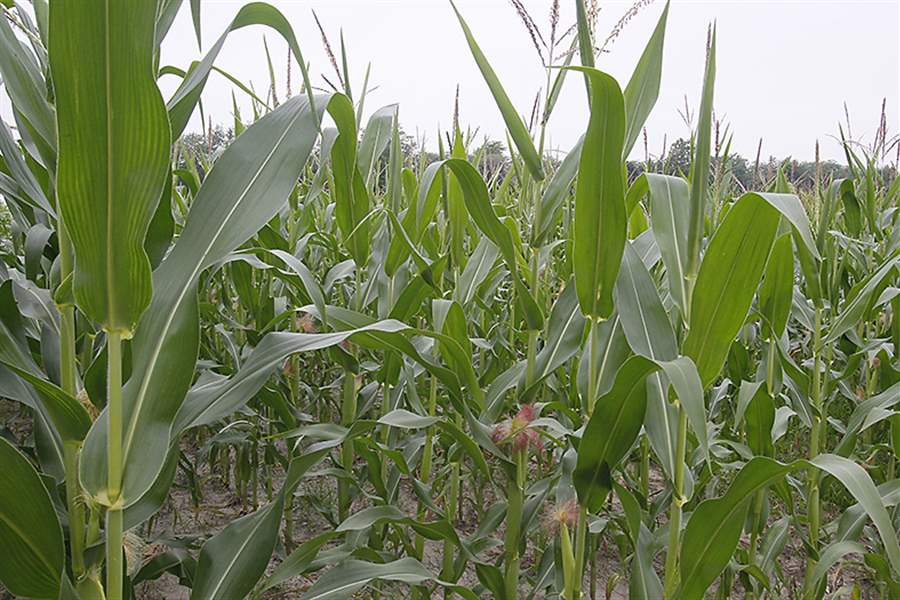
THE DELIGHT OF RAIN AFTER A DROUGHT
Typical soybean, corn yields likely in Ohio, Michigan
7/29/2013
A soybean field in Oregon in eastern Lucas County looks lush this year. Last year many crops across the region struggled with far too little moisture and way too many super-hot days.
THE BLADE/JETTA FRASER
Buy This Image

A soybean field in Oregon in eastern Lucas County looks lush this year. Last year many crops across the region struggled with far too little moisture and way too many super-hot days.
Nobody’s talking about the drought anymore.
This year’s moderate temperatures and seemingly constant rainfalls have northwest Ohio’s field crops looking much better than they did a year ago, when much of the country was struggling with a historic dry spell.
Agricultural observers say this year isn’t likely to give farmers a bumper crop, but as long as the weather stays relatively normal from here on out — never a guarantee — it should be an average year for corn and soybeans.
Nearly all of Ohio’s wheat has been harvested, and experts say that though wet weather delayed the harvest a bit for some farmers, it was a fairly normal crop.
Still, in much of northwest Ohio, there’s a good side and a bad side to the year’s story.
Ottawa County farmer Kevin Fox said the lush corn crop looks as good as he’s ever seen it at this point in the year.
However, Mr. Fox said his soybeans have been devastated by the rain.
“The potential was outstanding when we got them planted,” he said. “They came up good, they were growing good, and then the rain started.”
Rainfall has varied across the region, but it’s well above average.
In Toledo, the National Weather Service has measured 19.8 inches of rain so far this year, nearly five inches above average.
Mr. Fox guesses he’s lost at least a third of his soybean crop because of that extra rain.
“We’ve had way too much water,” he said.
That’s also been the case in parts of Wood County.
“Soybeans are probably the worst as far as excess rainfall damage. Standing water can kill the soybean plant and can also allow for disease infection,” said Alan Sundermeier, the Ohio State University agricultural extension agent for Wood County.
Weather is always somewhat variable. One farm may get a little more rain than another a few miles down the road, or dodge a severe storm that hits nearby. But Mr. Sundermeier said that’s been even more pronounced this year.
“Some of these isolated downpours caused the flooding to be more localized, but overall for the whole area we are above average for rainfall.”
Though there were some strong storms that rolled through the region earlier this month, most of the corn crop has recovered and looks good, Mr. Sundermeier said. But water-damaged bean fields aren't likely to recover.
Still, overall he predicts mostly average yields when looking at the county as a whole.
Carl Zulauf, an agricultural economist at Ohio State University, said U.S. crop conditions are average to above average.
The U.S. Department of Agriculture’s weekly crop progress report, released Monday, shows 63 percent of corn and soybeans in good to excellent condition nationally, far above where they ranked at the same point last year. The report shows 70 percent of Ohio’s beans and 79 percent of Ohio’s corn in good to excellent condition.
“At this point in time you would say it’s at least a normal crop overall, with some pockets of problems,” Mr. Zulauf said.
He noted parts of Ohio hurt by excessive rain and flooding this month.
“The question will be whether or not the yield becomes larger in the rest of the field to make up for what’s lost in low-lying areas,” Mr. Zulauf said.
For farmers who didn’t get too much rain, though, the year is shaping up well.
“Overall, I’m very optimistic about our production this year,” Bowling Green area farmer Paul Herringshaw said. “The corn looks very good. I got in the ground in good shape, and got it up, and we’re in an area where we've had plenty of rain.”

A Sylvania Township corn field is one of many locally that look good, a tribute to timely rain and moderate temperatures.
He said his corn is looking as good as it has looked in several years, and in spite of rainfall totals that border too much, his soybeans are looking good.
Still, he acknowledged not everyone has been so lucky.
“I feel for them because there are some soybean fields that they’re probably at best half a crop because the excessive rains have created flooding conditions,” he said.
After two years of worrying about corn yields around this time of the year, Mr. Herringshaw said he thinks there’s a lot of excitement about what may be in store.
However, he quickly notes that there’s a lot of growing season to come before harvest.
The story is similar in Michigan.
Jim Hilker, an agricultural economist at Michigan State University, said flooding there hasn’t been as widespread as it was in Ohio, and overall, the state’s crops are doing well.
Michigan crop reports rate 70 percent of the state’s soybeans good to excellent and 73 percent of the corn crop the same.
“I think we could have some excellent crops in certain areas,” Mr. Hilker said.
Though crops could use a bit more heat, he’s expecting average yields for corn and soybeans.
“If we have [average weather] from this point on, we ought to do all right,” Mr. Hilker said.
Contact Tyrel Linkhorn at: tlinkhorn@theblade.com or 419-724-6134.